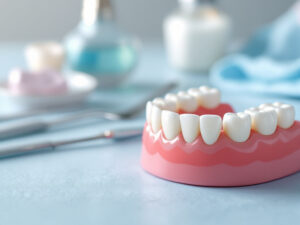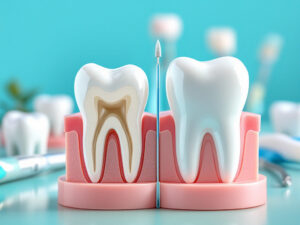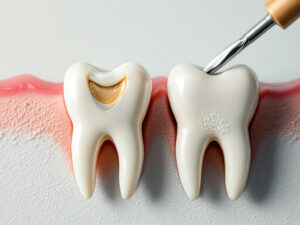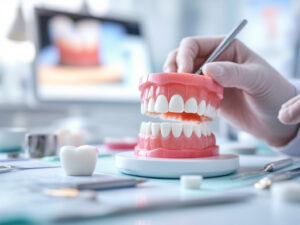Understand root canal therapy
If you have ever experienced persistent tooth pain or sensitivity, you might already have come across the option of root canal therapy. This proven method is designed to remove infection and safeguard your natural tooth, often sparing you from more involved procedures down the line. At Cloninger Dentistry, we recognize that you want a practical solution that eases pain and anxiety, while also preserving your smile for years to come. Root canal therapy achieves all these goals by targeting the source of pain quickly and effectively.
Before you decide whether it is right for you, it is important to understand the fundamentals. According to the American Association of Endodontists, pulp inflammation or infection inside your tooth can arise from deep decay, physical trauma, cracks, or repeated dental procedures. When left unchecked, such infections may spread, leading to significant discomfort, abscess formation, and even potential tooth loss. Root canal therapy addresses these concerns by cleaning out the source of the problem, sealing the canals, and allowing the tooth to function normally again.
It is worth noting that around 15 million root canals take place in the United States each year (Cleveland Clinic). This statistic highlights not only how frequent the procedure is but also how well-understood and reliable it is to help you and your loved ones. Whether you are seeking to maintain a healthy, attractive smile or you are nervous about the discomfort you might face, root canal therapy can be a pivotal step toward preserving your dental health.
Why it is necessary
Root canal therapy becomes necessary when the soft tissue inside your tooth (referred to as the pulp) is affected by inflammation or infection. Your tooth pulp contains blood vessels, nerves, and connective tissues, all of which can become vulnerable to bacterial invasion. Tooth decay is a common cause, but even subtle injuries or cracks that do not show on the surface can create a path for bacteria to enter. Once infected, the tissue cannot heal on its own, so professional intervention is crucial.
Early intervention can help you sidestep more serious issues. If your tooth infection continues to progress, it may require a tooth extraction service, which is more invasive and often pricier when you factor in the cost of an implant or bridge to replace the missing tooth. By opting for root canal therapy, you save the tooth structure, maintain your natural chewing ability, and preserve a uniform appearance in your smile.
Common signs you need this procedure
While not every toothache automatically calls for root canal therapy, there are certain indicators that suggest you should consult your dentist:
- Persistent tooth pain that keeps you awake at night or distracts you during the day
- Sensitivity to hot or cold that lingers, even after you remove the source of the temperature
- Swelling or tenderness around the gums
- Tooth discoloration or darkening
- Pain when you are biting down on food
If you recognize any of these symptoms, it is wise to schedule an evaluation. At Cloninger Dentistry, our team can determine whether the pulp is infected and recommend an approach that best fits your situation.
Explore the procedure steps
One of the most effective ways to gain confidence about root canal therapy is to understand the process in detail. The typical root canal procedure is straightforward and generally completed in one or two appointments, depending on the severity of your infection.
Step 1: Examination
Your dentist will first perform a thorough examination, using diagnostic tools like digital xray imaging and, if needed, 3d imaging dental diagnostics. These scans help identify the infected areas in your tooth and evaluate the shape and depth of your root canals. You may also receive a private dental consultation, during which the dentist outlines the extent of the infection, the procedure timeline, and the estimated costs.
Step 2: Numbing
Next, an anesthetic is administered to ensure that you remain comfortable. Contrary to common fears, the injection process is typically quick, and the numbness sets in within minutes. Modern techniques and local anesthetics are designed to minimize discomfort. The Cleveland Clinic notes that root canal treatments are usually as painless as a routine dental filling.
Step 3: Removing the infection
Once the tooth is numb, the dentist places a small protective covering around the tooth to keep the treatment area sterile. Using specialized tools, the dentist creates a small access point to reach the infected pulp, removing it gently. The canals are then cleaned, disinfected, and shaped. If necessary, antibiotics may be applied to eliminate lingering bacteria and reduce your risk of reinfection.
Afterward, a biocompatible material is placed within the canals to seal them. In many cases, your dentist will also recommend placing a temporary or permanent filling or crown to fortify the tooth against future damage. This is especially common if the tooth structure has weakened over time.
Recognize the benefits
Root canal therapy offers a range of advantages that extend beyond just pain relief. By targeting the underlying cause of your toothache, this procedure gives you a lasting solution. Here are some of its top benefits:
Pain relief
Persistent tooth pain can adversely affect your day, making it hard to concentrate, eat, or even get a good night’s sleep. Since root canal therapy clears out the infected pulp that is causing your discomfort, you typically experience significant relief shortly after the procedure. Though you may feel mild soreness once the anesthesia wears off, most patients find that this fades within a few days or less. Over-the-counter pain relievers, such as ibuprofen, can help you stay comfortable during this recovery phase.
Save your natural tooth
When the infection reaches the pulp, some mistakenly assume that tooth extraction is their only choice. However, removing a tooth can lead to issues like shifting teeth, bite misalignment, and difficulty chewing certain foods comfortably. By acting promptly with root canal therapy, you or your loved one keeps the natural tooth in place. This preserves both the aesthetic appearance of your smile and your overall oral function.
Prevention is another aspect to keep in mind. As you maintain healthy teeth for the long haul, you reduce the likelihood of needing more extensive procedures, like dental bridge placement or an implant, both of which cost more and require multiple visits to replace a missing tooth.
Lower overall cost
Although the upfront cost for a root canal may seem significant, retaining your natural tooth can be more economical in the long run. Alternatives like extractions and replacements often involve additional procedures such as dental crown placement or implants, which ultimately lead to higher overall fees. Most dental insurance policies also offer coverage for endodontic treatments, reducing your out-of-pocket expenses.
Debunk misconceptions
For many, the term “root canal” carries negative connotations. Let us take a moment to erase the myths and place the facts front and center.
“All root canals are painful”
You might have heard that root canals are excruciating. However, advancements in modern dentistry have drastically changed that outcome. According to the American Association of Endodontists, the pain comes from the infection itself, not the procedure. In fact, the procedure is specifically designed to relieve pain by eliminating the infected pulp. Modern anesthetics and calming techniques help ensure that you remain as comfortable as possible. Many patients return to their daily routines, such as work or school, on the same day.
Some temporary soreness or mild discomfort within the first few days is common, but it is generally manageable with simple home-care practices like warm salt-water rinses and over-the-counter pain relievers. So rather than intensifying your discomfort, a root canal almost always brings relief and a healthier long-term outlook for the tooth.
Care for your tooth after the procedure
Following root canal therapy, your mouth begins the healing process. To promote fast recovery, you will need to follow some straightforward aftercare recommendations.
Recovery timeline
Most patients feel comfortable enough to resume typical routines within 24 hours. You might experience some mild sensitivity or swelling in the treated area, but this usually subsides within a week. If pain lingers for more than a week, it is best to contact your dentist or healthcare provider. Cleveland Clinic experts note that persistently severe pain could be a sign of complications that require prompt assessment.
Your dentist will likely schedule follow-up appointments to monitor your healing, make sure the tooth’s seal is holding, and confirm that no recurrent infections have developed. If a permanent restoration like a crown is necessary, you may need an additional visit.
Long-term care
In the weeks and months following your root canal, proper oral hygiene can significantly reduce the odds of reinfection. By brushing at least twice daily, flossing once a day, and keeping regular routine dental checkup appointments, you ensure that your tooth restoration remains strong and intact.
Beyond brushing and flossing, you might also consider discussing preventive treatments and services with your dentist, such as fluoride treatment or oral cancer screening. Regular dental cleanings and thorough exams help detect early warning signs of any new problems, allowing you to address them before they escalate.
Choose Cloninger Dentistry
Deciding which dental practice to trust with your root canal therapy is a significant step for your health and peace of mind. At Cloninger Dentistry, our team strives to build a dependable, empathetic environment that supports you from your first consultation to your final follow-up.
Expertise and advanced methods
Many people worry about the worst-case scenarios, like an incomplete procedure or reinfection. Our commitment to comprehensive diagnostic imaging, such as intraoral camera examination and 3d imaging dental diagnostics, drastically decreases the chance of missing hidden canals or complex infections. This meticulous approach helps ensure a thorough cleaning, shaping, and sealing, leading to a successful recovery.
We also stay apprised of new dental materials and methods to make the entire process more comfortable and efficient. Whether this involves the latest endodontic tools or innovative sedation options, we keep your well-being at the forefront.
Comprehensive family care
At Cloninger Dentistry, we recognize that a healthy smile is essential, not just for you but for your entire family. Root canal therapy is just one of many services we provide to maintain and enhance oral health. We welcome children for pediatric dental care and offer convenient options for the older members of your family, such as custom denture fitting. Whether you need a professional teeth cleaning or advanced restorative treatments like porcelain crown service, our team is prepared to create a plan tailored to your needs.
We understand that finances can be a hurdle, so we also maintain an insurance friendly dental practice, giving you clear, upfront pricing and guidance. We even provide flexible financing dental solutions for large or unexpected procedures, making it more convenient to get the care you require when you need it. If you want a detailed overview of your treatment costs, let us know, and we will always provide a written treatment estimate.
Our focus remains on delivering an experience that is both empathetic and informative. We listen to any concerns you have, help you navigate the entire course of your treatment, and encourage you to ask questions. This supportive environment empowers you to make sound decisions for you and your loved ones.
FAQs about root canal therapy
-
Will my tooth hurt after the procedure?
It is common to feel mild tenderness or sensitivity in the treated tooth for a few days, but severe or persistent pain is not typical. Over-the-counter pain relievers usually alleviate most discomfort, and your dentist can prescribe medication if needed. If pain lasts beyond a week, you should contact a professional for an evaluation. -
How many visits will I need?
The majority of root canal therapies are completed in either one or two appointments. The number of visits varies according to how complex your tooth infection is. Your dentist will advise you on how many appointments you might require, so you can plan around your schedule. -
Is it better to extract the tooth instead?
Whenever possible, saving your natural tooth is the preferred option for maintaining normal chewing ability and tooth alignment. Extractions can lead to complications such as shifting teeth or the need for dental implants, which are generally more expensive and time-consuming than a root canal. Nonetheless, if the tooth is severely damaged and unsalvageable, an extraction may be recommended. -
Can I return to work immediately?
Many people resume their normal routine, including work, on the same day. You will likely still feel numb for a few hours after the procedure, so avoid eating until that sensation subsides. If you have lingering discomfort, you may consider taking the rest of the day off, especially if your job involves physically demanding tasks. -
Why should I choose Cloninger Dentistry for my root canal therapy?
At Cloninger Dentistry, you benefit from our advanced technologies, proven expertise, and a caring team that sees you as a valued individual rather than just another patient. Our detailed diagnostics and comprehensive approach ensure that each step of the procedure is done meticulously, reducing your risk of reinfection. Plus, with our insurance friendly dental practice and transparent communication, you can confidently plan for treatment and focus on a swift, successful recovery.
Conclusion
Root canal therapy is a time-tested procedure that takes aim at tooth infections and pulp damage without requiring you to give up your natural tooth. Thanks to modern methods, the procedure itself tends to be little more uncomfortable than getting a regular filling—and the payoff is potentially huge. You not only find relief from persistent pain, but also preserve your tooth function and oral health.
At Cloninger Dentistry, we strive to offer you and your loved ones a practical solution grounded in both empathy and expertise. Our goal remains to cultivate a supportive environment where your concerns and questions are listened to, and where you feel guided at every turn. If you suspect that you may need root canal therapy, or if you simply wish to maintain healthy teeth and gums, you can rely on us to provide exceptional care. We look forward to helping you achieve the comfortable, confident smile you deserve. Schedule an appointment to learn more about preserving your dental well-being, and let us show you the difference a patient-centered approach can make.










